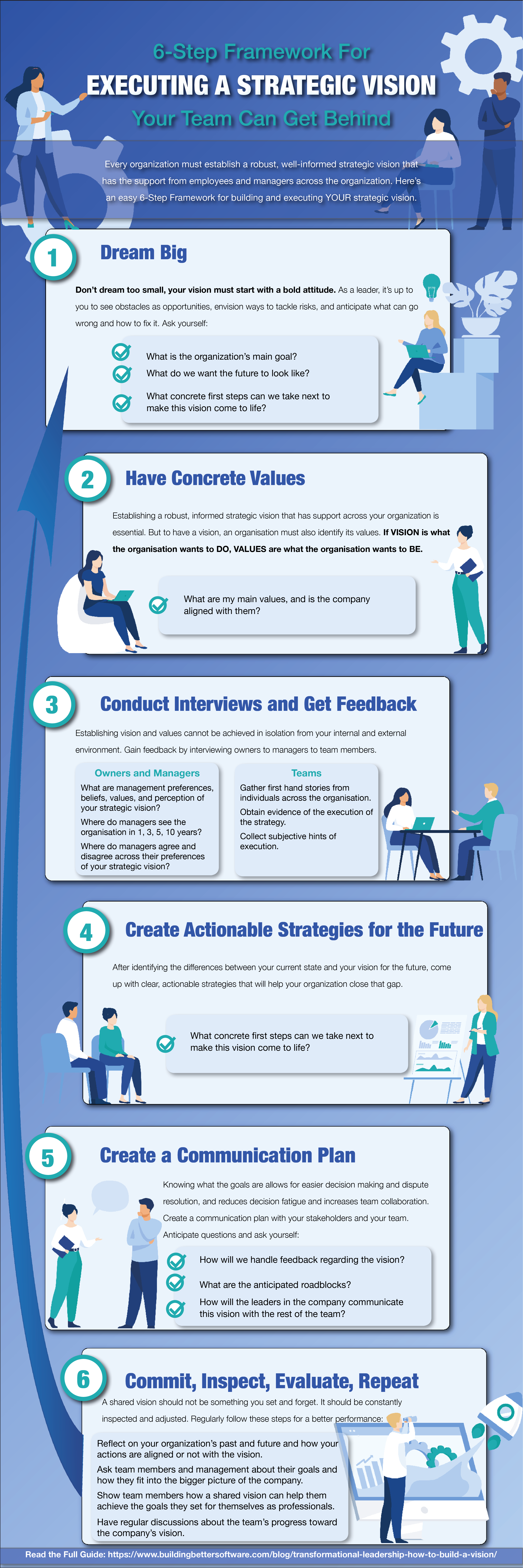In the media, “Vision” quickly became an overused word, so if you consider it a cliché, meaningless term, we understand where you’re coming from. But, hopefully, this article will show you why having a vision is a fundamental driving force in any company, and how building a vision your team can embrace is one of the key contributions a leader can make to an organization, whether or not you choose to use the word itself.
A vision is different from a mission, purpose, or values. A vision answers the question: “what world do you want to create?” It is about envisioning a positive place in the future where the world will be better because of your organization’s contribution. On the other hand, a mission is why you want to get to that vision, and values describe how you want to go about achieving the vision.
A study conducted by the Harvard Business Review asked people what is, for them, the most important attribute in a leader. After honesty, the key attribute people identified was this: being forward-looking. 72% of the respondents considered this an important characteristic and, in senior roles, that percentage reached an impressive 88%.
It is clear that a leader’s role is deeply connected with turning everyone in the same direction—the future—and creating a clear picture of what that future will look like in people’s imaginations.
What Is the Value of Building and Sharing a Vision?
While a leader can have a personal vision for the organization, this won’t be worth much unless it’s shared with others. A vision is something greater than any one person. It should expand beyond a personal view, as well as live on once that person is gone.
When a leader creates a vision, the goal is that others can take it in, make it their own, and carry it forward. A vision should be something that lives within the organization, regardless of who will be part of it in the future.
To build a vision as a leader, you should ask yourself questions such as:
- What is the organization’s main goal?
- What are my main values, and is the company aligned with them?
- What do we want the future to look like?
- What concrete first steps can we take next to make this vision come to life?
In larger organizations, it is unrealistic to think you can be aware of every small move and decision. That is why a crucial part of developing a vision is to find ambassadors who will understand it and embody it. These are people with regular positions within the company, but their responsibilities also include cultivating enthusiasm for the vision amongst their peers and subordinates.
More than a theoretical concept, a company’s vision is something that brings tangible benefits to any organization. Studies show that an effective vision generates positive organizational outcomes. Employee satisfaction is strongly driven by purpose and meaning in the workplace. Therefore, a clear vision contributes to everyone’s understanding of the bigger picture and how their daily tasks fit into it. Employee satisfaction then leads to commitment and loyalty which, in turn, increase productivity and profitability.
Building a clear vision also helps your organization in several practical ways when it comes to making decisions, contributing to reducing decision fatigue:
Clarified Decisions
Having a vision serves as a compass that points the direction in all the decisions made within the organization. It reduces the weight of personal opinion, aligning everybody with the same shared ideas.
Decentralized Decisions
If everyone has a shared vision of the company, the need to micromanage decreases drastically. People can be trusted to make decisions without relying on management because they know what is the compass guiding the organizational decisions and can apply it on their own.
Easier Decision-making
People in your team will disagree on certain aspects, this is unavoidable. But when such disagreements emerge, a company vision acts as a uniting force that overrides these different opinions, helping you arrive at a decision faster.
Transformational Leadership and DevOps: A Natural Partnership for Success
While change might seem like something that brings novelty and excitement, be aware. In his book, “A Sense of Urgency,” John Kotter declared that 70% of organizational change initiatives fail. Subsequent studies challenged this number, but they all kept it at a high level.
While there are many reasons contributing to this, the main one is related to failure in changing the company’s culture. People naturally react adversely to change, as it challenges the security we all aim for. Consequently, organizational change requires leaders to consciously address this culture adaptation as a priority.
In Agile and DevOps, teams are self-organizing. They define their tasks and set their priorities, diminishing the need for managers to lead them. For a manager who has not worked in an Agile way before, transitioning into such a framework can lead to worries such as “If teams organize themselves, what will be my role?” which can lead to failure when implementing transformational leadership.
DevOps is a philosophy that has its roots in Agile methodologies. It is based on shared ownership, workflow automation, and rapid feedback. These are all key factors that can help navigate change in an organizational environment.
When the DevOps philosophy is adopted, teams adapt to change faster and more easily. Instead of fearing it, they constantly incorporate it in daily tasks and contribute to creating a company culture that responds quickly, therefore achieving the principles of Agility, and facilitating the implementation of transformational leadership. Implementing DevOps in your company is something you should start considering even before you start writing your company’s vision.
How BuildingBetterSoftware’s Digital Transformational Model Can Help Achieve Organizational Change
As we’ve seen above, organizational change has a high chance of failing. However, at BuildingBetterSoftware we’ve developed a digital transformation model that aims at reducing these failure statistics by improving the quality and accelerating the speed of feedback, continuously assessing an organization’s narrative as a means of managing effective change and transition.
We’ve divided our model into three main phases: Orientation, The Path, and The Grind.
At Orientation, we assess the organization’s strategic aims, answering questions such as: Which changes does senior management want to achieve? Which cultural or organizational changes does management want to see realized? What is the desired end-state of the organization in a few years’ time?
During The Path, we reflect on how we can put the previously defined objectives into practice. We assess the routines, processes, habits, and practices that should be adopted to achieve change, and how to communicate it across the organization.
Finally, at The Grind phase, we analyze how we can measure progress. We answer questions such as: How does management know the changes are working? How does the rest of the organization know? And how does the organization make sure the progress continues?
Implementing this model brings on three main benefits. Firstly, it reduces the lead time to organizational change, as it benefits an iterative approach that allows the organization to learn earlier and iterate faster than traditional approaches. Secondly, it allows real-time transparency on change progress because it emphasizes transparency through the entire lifecycle of strategy and execution. Lastly, it brings about working results, which are the only real measure of the successful design and deployment of a change strategy.
As Peter Drucker put it, “strategy is a commodity, execution is an art”. At BuildingBetterSoftware, we create models that contribute to rationalizing the art of execution.
How To Build a Strategic Vision and Share It as a Leader
Now that we have established the importance of a shared vision, let’s see how you can create one for your organization. This is not a strict guide, as you might find there are other techniques that fit your organization specifically but, in general, this is how you can start:
1. Have a Dream
Everything created by humans was once just a dream, some idea inside someone’s mind. This is how it all starts, and it is where you should start too.
Don’t dream too small, your vision must start with a bold attitude. It is up to you, as a leader, to see obstacles as opportunities, envision ways to tackle risks, and anticipate what can go wrong, and how to fix it. During this phase, ask yourself questions such as:
- Is my vision entrepreneurial?
- Is my vision actionable?
- Is my vision relatable within the organization?
2. Consider Values
Here, you should do a thorough analysis of the current values of the company and the ones your vision is about. How do they compare? What is already being done? What is missing?
Even if you come to dissatisfying conclusions — for example, that your current status is far behind what you would like to achieve — it’s important that you’re honest. You can’t expect people in your organization to believe a false vision. If your vision is about equality but there are clear inequalities within the company, people will see your ideas more as propaganda than a vision.
3. Create Strategies for the Future
Now that you have identified the differences between your current state and your vision for the future, come up with clear, actionable strategies that will help your organization close that gap.
This requires a fine balance between respecting stakeholder’s interests and being adaptive to implement the necessary changes.
4. Create a Communication Plan
Once you have your vision, you need to take the next logical step: communicate it to everyone involved. This is fundamental to achieve the success you aim for. Create a plan to communicate with the stakeholders, and with your team as well. Anticipate communication questions that might arise in the future and ask yourself these questions:
- How will we handle feedback regarding the vision?
- What are the roadblocks I anticipate?
- How will the leaders in the company communicate this vision with the rest of the team?
5. Commit
Keep in mind this precious communication rule: “show, don’t tell”. Well, you can (and should) tell people about it but, most importantly, show them regularly how to apply this vision to their work. Actions and behaviors are key to make people understand your vision, and for them to realize that this is something more than just words. Vision is part of the company’s life and something that is reflected in everything you do.
A shared vision should not be something you set and forget. Rather, it is something that should constantly be inspected and adjusted. Consider following these practices to reach better performance:
- Make sure to carve out time on a regular basis to reflect on the past and the future of your organization and how the actions are aligned or not with the vision.
- Regularly ask members of the organization about their goals and how they see them fitting into the bigger picture of the company.
- Show team members how a shared vision can help them achieve the goals they set for themselves as professionals.
- Have regular discussions with others about the team’s progress towards the company’s vision.
You can find the downloadable, sharable guide here.
Conclusion
Even if it sounds counterintuitive, the best way to lead people into your future vision is to connect with them in the present. It is by observing, hearing, and empowering them that you create in your teams a shared sense of ownership of the future you set out to build.
A leader without a vision is just another team member. But a leader without a team is nothing. Dream big, create your vision and then share it with those who will bring it to life. Your role is not only to shine a light on the path to take but also to motivate people to walk along that path with you.
This will turn your employees into real teams and empower your organization in ways that would never be achievable without a common sense of where you are heading. And wherever that is, there is just one way to get there—together.

Søren Pedersen
Co-founder of Buildingbettersoftware and Agile Leadership Coach
Søren Pedersen is a strategic leadership consultant and international speaker. With more than fifteen years of software development experience at LEGO, Bang & Olufsen, and Systematic, Pedersen knows how to help clients meet their digital transformation goals by obtaining organizational efficiency, alignment, and quality assurance across organizational hierarchies and value chains. Using Agile methodologies, he specializes in value stream conversion, leadership coaching, and transformation project analysis and execution. He’s spoken at DevOps London, is a contributor for The DevOps Institute, and is a Certified Scrum Master and Product Owner.
Value Stream Optimization?
We specialize in analysing and optimizing value streams.



0 Comments